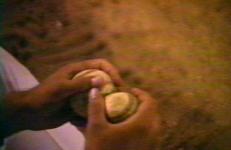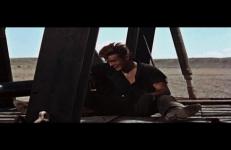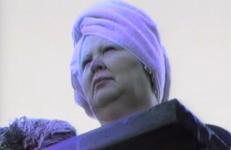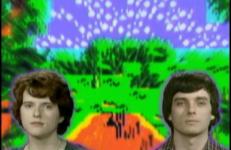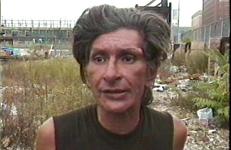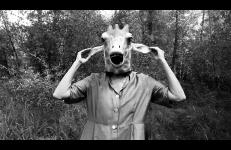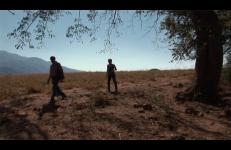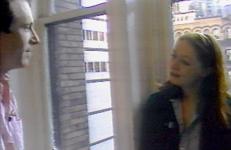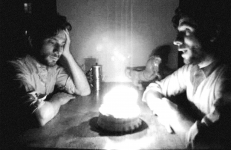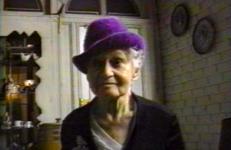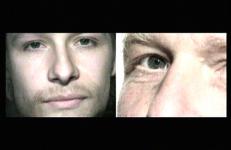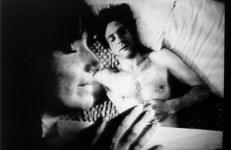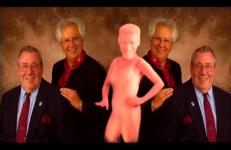Thinking of herself as a spy assigned by the female sex, Green reinterprets baseball’s symbolism—its womblike landscape, its cycles and rituals—and constructs an iconography that pays homage to the female. In one magnificent montage, numerous phallic symbols pass by as Green sees the real purpose of the game: baseball is the only sport about returning home—and where is home...? In a mother’s belly. With humor and irony, Green creates a tape that is both a personal revelation and a heretical portrait.
Family
stammering forward backward GIANT is a re-edit of George Stevens' 1956 film Giant - an epic story of Texas, oil and racism. Condensed to 17 minutes and beginning in the middle, stammering forward backward GIANT implements improvisational percussive frame by frame editing structures to simultaneously unwind the film to the conclusion of beginning and end.
Told through the voices of three elderly South Carolinian's who reside in the homes in which they were born, Steven Go Get Me A Switch is an oral history mapping dichotomies of gender, familial mythologies, sexuality, and belief. A heavy use of symbolism comingles with suggestions of narrative proof. The desire to be good and the impossibility of such desire becomes a sharp inaudible pitch, like a dog whistles call to violence.
still/here is a meditation on the vast landscape of ruins and vacant lots that constitute the north side of St. Louis, an area populated almost exclusively by working class and working poor African Americans. Though it constructs a documentary record of blight and decay, still/here is a refusal of closure that dwells within the space of rupture and confronts the presence of a profound absence.
–– Christopher Harris
Camera, sound, edit: Christopher Harris
Additional camera: Joel Wanek
Made with my students at the San Francisco Art Institute, this video drama explores the thrills and terrors of the Big Top as a travelling circus comes to town bringing with it the promise of cotton candy, eternal youth, and high-flying beefcake. A mother and son become enmeshed in a web of sin and sawdust, licorice and lust, as a town confronts its own hideous image in a maze of mirrors at a carnival of lost and found souls.
This classic feminist tape deviates from David Byrne’s and Jonathan Demme’s popular 1980s versions of suburban life, True Stories. Rather than poking sarcastic fun at the woman locked in the split-level, Suburban Queen poignantly evokes a daughter’s longings. Portraying the relationship of a mother and daughter inextricably bound yet puzzled by each other’s lives, Faber recounts her frustration with her mother’s depression and passivity, and her fantasy of how her mother might transcend these conditions.
A wistful film on the love of homeland.
Video artist Nurit Sharett recounts her childhood memories and converses with her Palestine-born parents who grew up in the British Mandate years. They both took part in realizing the Zionist dream of establishing the State of Israel, a dream now shattered before their eyes.
After the shrieks and howls of Hymn of Reckoning, I felt that I needed to close out the Oto trilogy with a gentle flashback, to a 1980s sunset beach on a tropical island. The bulk of this video’s work was in animating the speech-bubbles so that they’d blend in with the VHS scene. Playing the scene once and ending the piece felt too fast and fleeting, and I feared that nuances in the conversation would be lost, so I approached it like a verse in a simple, one-part song: I repeated it once again, with just the slightest modifications to its sonic textures.
Sylvia is a portrait of the civil rights pioneer Sylvia Rivera for her memorial service in 2002, as told by her chosen family immediately following her death. "A veteran of the 1969 Stonewall uprising, Sylvia was a tireless advocate for all those who have been marginalized as the 'gay rights' movement has mainstreamed. Sylvia fought hard against the exclusion of transgender people from the Sexual Orientation Non-Discrimination Act in New York, and was a loud and persistant voice for the rights of people of color and low-income queers and trans people." --SRLP.org
Tales of a Future Past is a video about a giraffe and a zebra who fight over an undefined baby creature, in hopes of making it one of their own species. Using toy masks and a sparse theatricality, Cecelia Condit creates a contemporary reflection on species extinction and the lonely, silent world that will ensue from it.
Tell Me About Your Mother investigates matrilineal lineage, domesticity and creativity. Intimate and conversational, seven female artist friends and colleagues of mine—mostly boomers—recount their mother’s creative influence upon them. Additionally, each woman discusses the unique way(s) she distinguished herself from her mother.
Cande and Pancha’s daughter Maria Luisa and Marisela and Cachuchas’ daughter Veronica believe their fathers are locked in a competition for grandchildren. It’s now 3-0 Cande. Several years later, Cachuchas gives me a lesson in car repair then with Cande considers the change in score, 4-2 Cande.
Between job losses, foreclosures, living with family, and the Cande’s constant desire to return to Mexico, Pancha and Cande work through the strains of their marital relationship in San Diego County. Not able to have a house of their own, they resume the calmer life of renters, ending with a celebration of Cande’s 58th birthday.
Ramon's attraction to his Mexican hometown has resulted in his building a massive new residence for his family. However, his wife, Rufina and their grown children have no interest in leaving the U.S. The building has now been transformed into a hotel. The completed construction, in the middle of cornfields, while finished for 5 years, is been frustrated by the local government’s refusal to turn on the electricity.
First Ramon, and then Rufina moved to San Diego County in 1980, unable to raise their family as landless sharecroppers in Mexico. Though uneducated, they manage to work as a landscape contractor and housekeeper, respectively, buy a house, and raise 6 children who complete high school and maintain successful management jobs.
There But For resembles a soap opera; its characters—a couple whose relationship has seen better days, a ball-and-jack playing adult/child, and a couple that comes to visit the family—are in the midst of their day-to-day lives (an imitation of life). The music was composed and performed live on the set as the play unfolded. There But For is a free-form chance operation within the defined boundaries of place (an apartment) and the assigned roles of the players: the mother (bitch), the father (jerk), their kid (retard), and their visitors.
An 11-minute tape focused on greenish night-vision textures and certain high-camp performance values, organized around a dysfunctional family "celebrating" several birthdays. We see an elderly woman in apparent dementia staring as her "party" goes on around her, squares of blood-red sheet cake passed around the bedside. Monologue fragments purvey tragic bitchitude, wherein any birthday is a mere occasion for embarrassment and cruelty.
This film is the result of an intimate time spent between the filmmaker, who lives today in Belgium, and his father who is a former political prisoner. It looks at the complex political system of Egypt under Nasser.
This title is only available on Radical Closure.
A series of intimate video-8 vignettes depicting the fierce love between Malverna and Sandi, 88 and 22, grandmother and grandson. The two playmates dress up drag-esque for this moving portrait of a woman’s lifetime struggle with gender and sexuality. Since Malverna's death, Tomboychik has become a living memorial to the intensity of her spirit.
Back in the days of hippy bliss, Ulrike and her husband used to believe that the world would be revolutionized by their activities, consisting mainly of smoking pot and having sex. Thanks to a large family fortune, none of them has ever had to work for a living. But the ‘three generation millions’ – one generation makes it, the second maintains it and the third generation blows it – are slowly disappearing. So now the burden of maintaining the tower falls on the children, of whom Sirius (the Latin form of Osiris) actually seems to enjoy making money.
Begun as a consideration of the upgrading from manual to digital film editing techniques, Transitional Objects explores the anxiety and loss inevitable in such a transition while also suggesting the consequences of other life transitions. The video takes its title from D.W. Winnicott's theory of children's use of transitional objects to negotiate the gaps between internal reality and the shared reality of people and things.
In this interview, Los Angeles-based artist and filmmaker Ryan Trecartin (b. 1981) discusses his personal interests and motivations, as well as the larger cultural and philosophical concerns that shape his videos and their reception. Trecartin is known for his construction of non-linear narratives, campy costumes, and excessively visceral characters and environments. One of the most compelling aspects of this interview is his insistence that language and its verbal articulation, rather than the visual, anchor his process. Trecartin identifies the influences of 1990s retro-rave culture, hip-hop videos, and editing software tools on his work. He notes that the accelerated disintegration of high and low culture has played a major part in his growth as an artist.
Adapted from a performance by the same name, this courageous video fuses autobiographical material with information about how an alcoholic family perpetuates addictive behavior. Elements of Alcoholics Anonymous meetings, such as the “Hi, my name is...” introduction are used along with photo-montage and a disjointed narrative. In addition to being shown at venues such as the Museum of Modern Art and the New Museum, Trick Or Drink has been used regularly by hospitals and alcohol treatment centers throughout the United States.
I'm here to bring you the Truth and the Pleasure
Here to show you the meaningful form
It's going to feel like a new kind of leisure
It's going to smell like a freshly mown lawn
I'm installing a personal toolkit for thinking
Especially customized only for you
You enable it just by the action of blinking
From now on your thoughts will be focused and true
U & I dOt cOm is an experimental narrative/documentary hybrid about Zoey, a teenage girl who negotiates her identity in cyberspace. Dreaming about the perfect true love, she secretly navigates 3-D worlds to find romance. A web contest sweeps her into a dreamscape of desire and deception as hidden mechanisms of e-commerce, online data-mining, and real-time consumer profiling monitor her every move. When Zoey finally rebels, her sense of self, her home, and her relationship with her mother are forever transformed in the new cyber-cultural domain.




